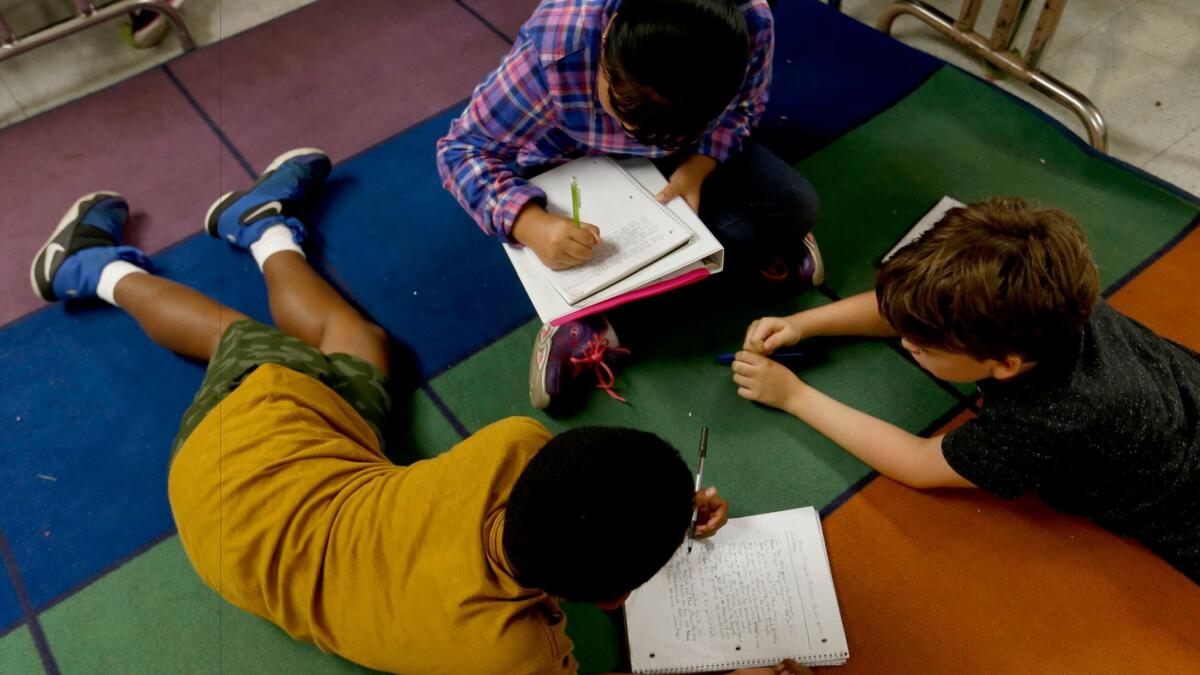Three crucial debates to follow at September’s California State Board of Education meeting

- Share via
How should California define underperforming schools and intervene in school districts that clearly need extra help?
Education officials have long been mulling these questions, but during the State Board of Education meeting on Wednesday and Thursday, they are expected to make key decisions and offer one last chance for public discussion of how the state will satisfy a crucial federal law.
Here are three key issues we’ll be following, and we hope you’ll join us. You can watch the meeting here.
1) What’s going on with last year’s test scores?
First up, the board is scheduled to discuss the California Assessment for Student Performance and Progress, the state’s standardized tests.
While the agenda item largely focuses on training and reporting for future administrations of the test, the public does not yet have access to school and school district scores from last school year. (Parents received reports of their students’ individual scores this summer).
The California Department of Education was supposed to release the latest testing data in late August. But a few days before the scheduled date, staffers said the release would be postponed indefinitely due to “data issues” — specifically, a problem with categorizing special education students’ scores within their districts.
At least one education statistician, Doug McRae, has noted that this particular problem would not affect statewide averages. But CDE officials say they don’t want to release scores at any level until they are certain the entire database is accurate. Unless there’s another change this week, we can expect the scores sometime next week.
2) What will the state’s final ESSA plan look like?
This summer, education experts sparred over California’s plan to satisfy the Every Student Succeeds Act, the 2015 replacement of the No Child Left Behind Act. The state’s plan — with the governor’s approval — has to be submitted to Education Secretary Betsy DeVos on Sept. 18.
Where No Child was reviled for being too prescriptive about how states should identify and sanction failing schools, ESSA gives states more agency — but still ultimately does require that states help underperforming schools. Under ESSA, states must identify the lowest-performing 5% of their high-poverty schools, as well as high schools with persistently low graduation rates, and help them improve.
Last month, a group of East Coast education experts released a report criticizing the state’s plan. David Sapp, the board’s deputy policy director and legal counsel, said the report’s conclusions were not valid because California is doing much more than the federal law specifies. Board president Mike Kirst also dismissed the critique.
Since the board’s last meeting, the state’s draft plan slightly changed the definition of an “ineffective teacher,” removing “intern-credentialed teachers” from those who can be listed in that category. Teach for America corps members are intern-credentialed.
Several groups filed letters with the board in advance of the meeting calling for broader changes. Samantha Tran, the senior managing director of education for Children Now, a group that lobbies and organizes activists on behalf of children's rights, wrote that the plan lacked a key “focus on equity.”
With so little time left before the deadline, it’s hard to imagine the plan will change significantly. Kirst has said the plan is just one plank of California’s overall efforts at leveling the educational playing field and that he deliberately is keeping details minimal.
“The Board should consider the central shortcoming of the current draft of the ESSA state plan … namely the lack of focus on equity."
— Samantha Tran, senior managing director of education for Children Now
How should the state under its own laws help underperforming school districts?
This subject is also coming up Wednesday. The Local Control Funding Formula, a major California school finance law, came with its own school accountability system, separate from the federal government’s requirements. Under LCFF, the state must identify and assist low-performing school districts.
The board will discuss how the state and county education offices should work with those districts. This November, county superintendents are supposed to contact districts eligible for extra help. Districts are supposed to conduct assessments to get at the root causes of their problems.
Ryan Smith, the executive director of the Education Trust-West — an Oakland-based nonprofit that advocates for educational equity — wrote to board members that he is concerned that the ideas for support give too much leeway to school districts. He urged the board to “require that an external agency or provider work alongside” districts in analyzing their problems, to “ensure that the district is sufficiently functional” to change.
In designing this process, the board is looking to other states. In Ohio, failing districts get extra technology, training and administrative services. In Texas, they can ask for specific things, such as discipline codes and special-education guidelines.
The board will discuss possible plans for helping school districts improve. The corresponding agenda item states that previous efforts for state intervention in underperforming districts have failed. The goal is for the new system to be different: Ideally, instead of imposing one-size-fits-all improvement plans, the state and counties are supposed to work with districts to create customized solutions.
To read the article in Spanish click here
Sign up for Essential California
The most important California stories and recommendations in your inbox every morning.
You may occasionally receive promotional content from the Los Angeles Times.








